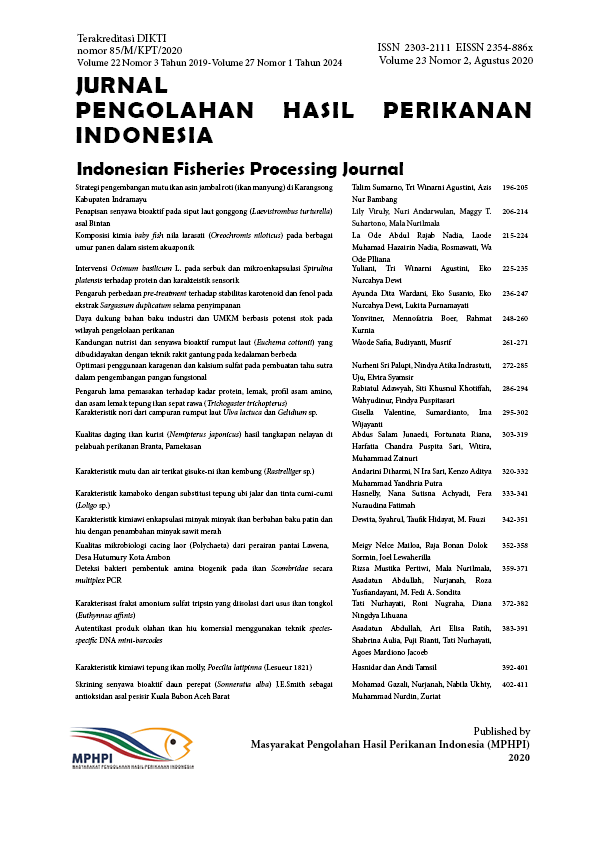Karakteristik Kamaboko dengan Substitusi Tepung Ubi Jalar dan Penambahan Tnta Cumi-Cumi (Loligo sp.) Characterization of Kamaboko with Sweet Potato Flour Substitution and Squid (Loligo sp.) Ink Addition
Abstract
The purpose of this research is to determine a ratio of tapioca to sweet potato flour and the concentration of squid ink producing high quality kamaboko. The quality of kamaboko was assessed organoleptically, chemically and physically. Two-stage research method was conducted. Firstly, a preliminary research, analyzing amino acids in squid ink and determining the best formulation. Secondly, the main research using a randomized block design (RBD) consisting of 2 factors, namely factor P (comparison of tapioca with sweet potato flour and factor T (concentration of squid ink). The responses consisted of organoleptic response, chemical response, physical response and selected response.The P factor affected color, aroma, elasticity texture, water content, ash content and protein content. The T factor influenced color, taste, aroma, elasticity texture, water content, and protein content. The interaction of the two factors affected the elasticity and protein content. The selected sample was kamaboko made from equal weight of tapioca and sweet potato flour (P) added with 3% squid ink. The sample had a color value of 4.34, aroma 4.44, flavor 4, 19, resilience texture 4.40, water content 54.44%, ash content 1.66%, protein content 14.69%, hardness 4,363.25 g force, elasticity 32.32%, color test ΔL * (Light) +2.58, Δa * (+ red/-green) -2.38 and Δb * (+yellow/-blue) -2.28.
Authors

This work is licensed under a Creative Commons Attribution 4.0 International License.
Authors who publish with this journal agree to the following terms:
- Authors retain copyright and grant the journal right of first publication with the work simultaneously licensed under a Creative Commons Attribution License that allows others to share the work with an acknowledgement of the work's authorship and initial publication in this journal.
- Authors are able to enter into separate, additional contractual arrangements for the non-exclusive distribution of the journal's published version of the work (e.g., post it to an institutional repository or publish it in a book), with an acknowledgement of its initial publication in this journal.





